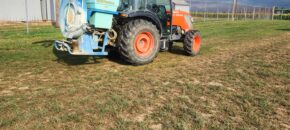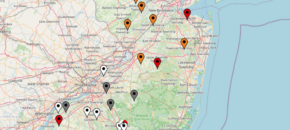Agri-Technology and Research Twilight Meeting at RAREC Thursday September 19th, 2024 4 pm until dark Location: Rutgers Agricultural Research and Extension Center (RAREC) 121 Northville Road Bridgeton, New Jersey 08302 This year’s twilight meeting at RAREC will continue to showcase new agricultural technologies for stakeholders in the state. We will showcase the newly operating agrivoltaics […]
Continue reading...The Rutgers Agrivoltaics Program launches a new website

The Rutgers Agrivoltaics Program is a multidisciplinary group of Rutgers faculty and staff committed to designing and conducting applied agrivoltaics research and outreach for stakeholders in New Jersey and throughout the region. The Rutgers Agrivoltaics Program (RAP) was initiated over 3 years ago with the signing and passage of the Dual Use Solar Act by […]
Continue reading...Beat the Heat: Companies for Farmers to Source Heat Stress Prevention Supplies

“Beat the Heat” Plant and Pest Advisory articles are provided by the Agricultural Agents on the Rutgers Farm Health and Safety Team: Kate Brown, Stephen Komar, Michelle Infante-Casella and William Bamka Protecting yourself and other workers from heat stress may involve purchasing some supplies for your farm operation. Some suggestions for items that may be […]
Continue reading...Vegetable IPM Update 8/28/24

Sweet Corn Fall armyworm (FAW) infestations continue in most scouted locations in central and northern NJ counties, although numbers are down. Pockets of heavier pressure remain. Re-infestations following treatment can and have occurred. Because FAW moths are highly mobile, it is important to monitor fields at least weekly for signs of infestation. Whorl, and […]
Continue reading...Twilight Meeting at Pleasant Run Nursery

September 20, 2024 5:30 pm to 7:00 pm 93 Ellisdale Road Allentown, NJ 08501 Join Carl Hesselein, President of Pleasant Run Nursery, and Rutgers Cooperative Extension for this FREE twilight meeting. We will tour the nursery and discuss best management practices for container production of native and low-input plant species. This twilight meeting will be […]
Continue reading...IMPORTANT: EPA Announces Voluntary Cancellation for the Pesticide Dacthal- NO USE OF EXISTING STOCKS (Ed Notes on AMVAC buyback)
Contact: EPA Press Office (press@epa.gov) WASHINGTON – Today, Aug. 28, following the U.S. Environmental Protection Agency’s emergency suspension of the pesticide dimethyl tetrachloroterephthalate (DCPA or Dacthal), the agency is initiating a process to… Read More »
Continue reading...